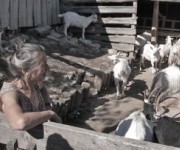Photo: Krystian OlszanskiFood Studies features the voices of volunteer student bloggers from a variety of different food- and agriculture-related programs at universities around the world. You can explore the full series here.
I’m in a food systems class this semester that is focused on the complex way that food moves from farm to plate (which in reality looks something more like from patented seed, to dirt treated with patented fertilizer, to harvesting by undocumented laborers, to processor, to manufacturer, to wholesaler, to a grocery store shelf with a paid stocking fee, to consumer, to plate). So far, our focus has been on consumer behavior, from the impact of food deserts to the ways that psychology and the economics of behavior effects food choice. (Did you know that putting out a bowl of multi-colored candy can increase consumption by well over 50 percent, compared to candy that’s a single color, for instance?) As we move on, economist and professor, Carolyn Dimitri, is helping us to understand the way that intermediaries like wholesalers and distributors factor in to the food chain.
There is a general resistance to analyzing food businesses the way we analyze other businesses, not only because food is our most primal need, but it’s also is fraught with cultural, nutritional, environmental, and political debate. At the base of it, though, large food businesses exist for the same reason large power companies do: to provide fuel and to make money. Like power companies, there are a few large food companies controlling the vast majority of the market. Take Coke and Pepsi. Tyson and Cargill. General Mills and Kellogg. Monsanto and Monsanto.
The idea of food monopolies isn’t new. In 1873, the Supreme Court heard the Slaughterhouse Cases, in which a monopoly had been given to Crescent City Livestock, a New Orleans slaughterhouse chain. Even then, food safety and environmental safety were concerns, as tons of animal waste from the slaughter process contaminated local drinking water.
Today, many of these same concerns remain, as huge companies like Smithfield dominate the slaughter and meat-packing market. The number of food producers (farmers) has been declining in the United States for decades, but it’s the production and wholesale sector, which turns raw food products into processed food, that has been most consolidated.
Here are some reasons that the current food environment makes large food monopolies possible, and how we can challenge them.
- Same old, same old. In the United States, federal and state laws make it nearly impossible for new, medium-sized meat processing companies to enter the market. Everything from the building of the physical space to food handling certification needs to be done in accordance with the federal and local authorities. In most cases, farmers are forced to have their meat processed at large, tech-savvy plants — even if they are miles away from their farm. Mobile meat processing, which was only recently approved by the USDA, is one way to connect certified processors with smaller scale farmers for convenient, safe meat production.
- Keep the technological playing field uneven. Corporations like Monsanto and Nabisco fund huge research projects at universities, which help them gain and maintain the most up-to-date science. By better funding sustainable food research at universities worldwide, we can ensure that science that promotes sustainability takes priority over science that promotes profits for processors and input suppliers.
- Let processors pay to play. There is no scarcer resource in a supermarket than shelf space. New products essentially can’t access shelf space unless an old product falls off. Thus the “slotting fee” which wealthy processors pay to supermarkets to gain or maintain access to premium shelf space. This system actually encourages mergers between organic and conventional farms, so that organic farms can rely on wide distribution channels to gain access to shelf space. By putting an end to paid real estate for processed foods, we can open space from produce bought directly from farmers.
- Keep the middle men around. While intermediaries add value to raw food products by storing them, transporting them efficiently, labeling them, and distributing them, they also seek out the lowest prices possible for goods. By buying directly from farmers, and going to restaurants that do the same, we put money in the pockets of farmers and not in those of huge wholesalers and processors.



